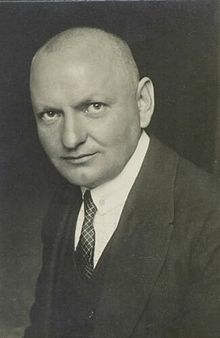Izidor Cankar
This article needs additional citations for verification. (January 2013) |

Izidor Cankar (22 April 1886 – 22 September 1958) was a
Early life
Izidor Cankar was born in
After finishing the study of
After the formation of a
In 1933, he founded the Slovenian section of the
Diplomatic and political career
In 1936, Cankar was named Yugoslav ambassador to
In February 1945, he went to liberated Belgrade and was named ambassador to Greece. In 1947, he returned to Ljubljana, where he worked as a consultant for the National Gallery and the Museum of Modern Art.[citation needed] He was critical of the communist regime, but did not engage in any political action. In 1953, he became a member of the Slovenian Academy of Sciences and Arts. He died in Ljubljana in 1958, age 72, and was buried in Žale Cemetery.
Writing
In his early years, Cankar wrote several renowned essays, mostly related to esthetic issues. In 1911, he published the book Obiski (Encounters), a collection of interviews with contemporary Slovene authors and artists (Ivan Cankar, Rihard Jakopič, Fran Saleški Finžgar, Ivan Tavčar, Oton Župančič, Franc Ksaver Meško, and others). In 1913, he wrote his only major literary work, the essayistic novel, S poti (On the Way), written as a travelogue through Italy. [citation needed]
In 1926, Cankar published a major treatise in art history, Uvod v umevanje likovne umetnosti (An Introduction to the Understanding of Figurative Art), where he developed a systematic stylistic typology based on the theories of Heinrich Wölfflin. In the same year, he started publishing his magnum opus, Zgodovina likovne umetnosti v zahodni Evropi (History of Figurative Art in Western Europe), in which he applied his own esthetic theory in the overview of western art between late antiquity and the Renaissance. Between 1926 and 1936, he published the first critical edition of collected works of the writer Ivan Cankar, his cousin. In 1948, he also published Ivan Cankar's correspondence. [citation needed]
Izidor Cankar was also a translator: among other, he translated works of Jonathan Swift, Patrick Augustine Sheehan, André Maurois and Immanuel Kant. [citation needed]
Publications
- Cankar Iz. S poti. Ljubljana: Nova knjižnica / Nova založba, 1919. 3, 117 s.; Z cesty // Návštěvy. Sv. 5. Eva, 1921. 131 s. (czech); 2nd ed. Ljubljana: Mladinska knjiga, 1996. 252 s.
- Cankar Iz. Uvod v umevanje likovne umetnosti. Sistematika stila. Izdaja 3.,. V Ljubljani: Karantanija, 1995. 185 s.
- Cankar Iz. Obisk na Rožniku In: Ivan Cankar, slovenski pisatelj: (1876-1918). Ljubljana: Mestni muzej, 1956.
Translations
- Lewis S. Babbitt / prevedel Izidor Cankar. Ljubljana : Državna založba Slovenije, 1953. 362 s.
- Swift J. Guliverjeva potovanja / prevedel Izidor Cankar. Ljubljana : Cankarjeva založba, 1967. 335 s.
See also
References
- ^ a b c Stanko Janež (1971). Živan Milisavac (ed.). Jugoslovenski književni leksikon [Yugoslav Literary Lexicon] (in Serbo-Croatian). Novi Sad (SAP Vojvodina, SR Serbia): Matica srpska. p. 59.
- ^ Alenka Puhar, Prvotno besedilo življenja (Zagreb: Globus, 1982), p. 346
- ^ Alenka Puhar, Prvotno besedilo življenja, p. 347
- ^ a b slo.slohost.net
- ^ 13. Izidor Cankar
- ^ Ana (Niča) Cankar (Hribar) (8 Jul 1907 – 8 Jan 1988), married 14 July 1926, Geneanet [1]
- ^ Izredna civilna poroka v Ljubljani Jutro. 1926. Št. 2 (18 July). S.3. [2]
Further reading
- Rahten A. Izidor Cankar: A Diplomat of Two Yugoslavias. Mengeš - Ljubljana: Center for European Perspective - Scientific Research Council of the Slovenian Academy of Sciences and Arts, 2009. 420 str., [16] str. pril.
- Rahten A. Izidor Cankar in Kraljevo jugoslovansko poslaništvo v Buenos Airesu = Izidor Cankar and the Royal Yugoslav Legation in Buenos Aires. Dve domovini : razprave o izseljenstvu = Two Homelands : migration studies. 2009. Št. 29. Str. 69-92. [3]
- Rahten A. Očrt slovenske diplomacije ali diplomacije slovencev. Teorija in praksa : revija za družbena vprašanja. 2011. Št. 3 (maj-jun.). Str. 646-667, 814. [4]
- Yugoslavia: El Mundo en Color. Textos de Jean Desternes, Izidor Cankar, Marcel Schneider, Mirko Hrovat y otros. Madrid: Ediciones Castilla, 1961. 448 pgs.
